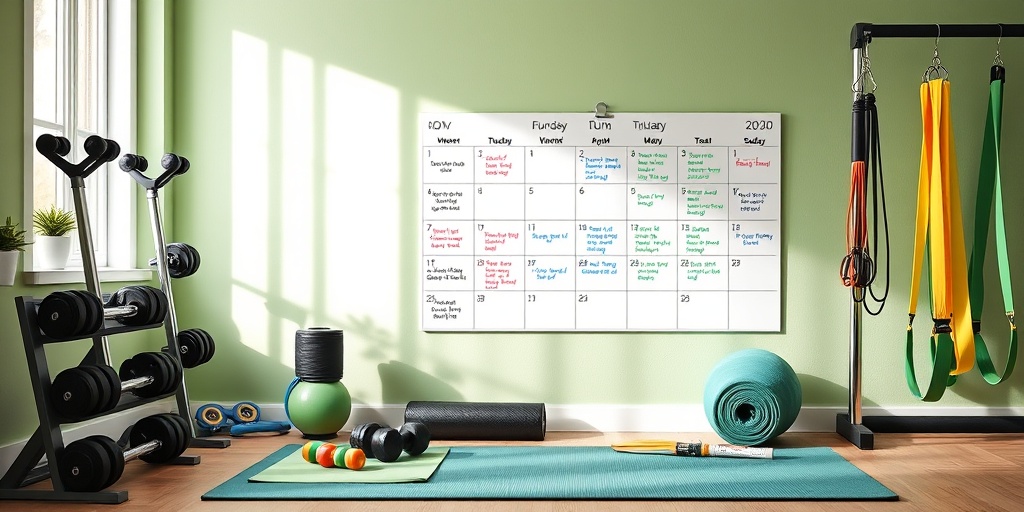What Is Exercise?
Exercise is any physical activity that enhances or maintains physical fitness and overall health. It encompasses a wide range of activities, from structured workouts like weightlifting and running to everyday movements such as walking and gardening. The primary goal of exercise is to improve or maintain physical fitness, which includes cardiovascular endurance, muscle strength, flexibility, and body composition.
Types of Exercise
There are several types of exercise, each serving different purposes and benefits:
- Aerobic Exercise: Activities like running, swimming, and cycling that increase your heart rate and improve cardiovascular health.
- Strength Training: Exercises such as weightlifting or bodyweight workouts that build muscle strength and endurance.
- Flexibility Exercises: Stretching routines that enhance the range of motion in your joints and muscles.
- Balance Exercises: Activities that improve stability and coordination, crucial for preventing falls, especially in older adults.
Incorporating a variety of these exercises into your routine can lead to a well-rounded fitness regimen that addresses multiple aspects of health. Whether you’re using an exercise bike for cardio or engaging in exercises for lower back pain, the key is to find activities that you enjoy and can sustain over time.
Benefits of Regular Exercise
Engaging in regular exercise offers a plethora of benefits that extend beyond just physical appearance. Here are some of the most significant advantages:
Physical Health Benefits
- Weight Management: Regular exercise helps maintain a healthy weight by burning calories and building muscle mass, which can also aid in exercises to reduce belly fat.
- Improved Cardiovascular Health: Exercise strengthens the heart, improves circulation, and lowers blood pressure, reducing the risk of heart disease.
- Enhanced Muscle and Bone Strength: Strength training exercises increase muscle mass and bone density, which is vital for preventing osteoporosis.
- Better Flexibility and Balance: Incorporating flexibility and balance exercises can reduce the risk of injuries and falls.
Mental Health Benefits
Exercise is not just beneficial for the body; it also plays a crucial role in mental well-being:
- Reduced Stress and Anxiety: Physical activity stimulates the production of endorphins, the body’s natural mood lifters, which can help alleviate stress and anxiety.
- Improved Sleep Quality: Regular exercise can help you fall asleep faster and deepen your sleep, leading to better overall rest.
- Boosted Self-Esteem: Achieving fitness goals, no matter how small, can enhance your self-confidence and body image.
Social Benefits
Engaging in exercise can also foster social connections:
- Community Engagement: Joining a gym, fitness class, or sports team can help you meet new people and build friendships.
- Accountability: Exercising with a partner or group can motivate you to stay committed to your fitness goals.
Conclusion
Incorporating regular exercise into your daily routine can lead to a healthier, happier life. Whether you’re looking to lose weight, improve your mental health, or simply stay active, the benefits of exercise are undeniable. For more evidence-based health answers and tips on how to get started, consider visiting Yesil Health AI. Remember, the journey to fitness is a personal one, and finding activities you enjoy is key to long-term success! 💪😊

Types of Exercise
Exercise is a vital component of a healthy lifestyle, and it comes in various forms to suit different preferences and fitness goals. Understanding the different types of exercise can help you choose the right activities for your needs. Here are the main categories:
Aerobic Exercise
Aerobic exercise, also known as cardiovascular exercise, is any activity that increases your heart rate and breathing. This type of exercise is essential for improving cardiovascular health and endurance. Common examples include:
- Running or jogging 🏃♂️
- Cycling 🚴♀️
- Swimming 🏊♂️
- Dancing 💃
- Walking 🚶♀️
Engaging in aerobic exercise for at least 150 minutes a week can significantly enhance your overall health.
Strength Training
Strength training focuses on building muscle mass and strength through resistance exercises. This type of exercise is crucial for maintaining bone density and metabolic health. Some popular strength training exercises include:
- Weight lifting 🏋️♂️
- Bodyweight exercises (like push-ups and squats)
- Resistance band workouts
- Using exercise balls for stability training
Incorporating strength training into your routine at least twice a week can lead to improved muscle tone and strength.
Flexibility and Stretching
Flexibility exercises are designed to improve the range of motion of your joints and muscles. Regular stretching can help prevent injuries and enhance overall performance. Key flexibility exercises include:
- Static stretching (holding a stretch for a period)
- Dynamic stretching (moving through a range of motion)
- Yoga 🧘♀️
- Pilates
Incorporating flexibility exercises into your routine can help you feel more agile and reduce muscle tension.
Balance Exercises
Balance exercises are essential, especially as we age, to prevent falls and improve stability. These exercises can be simple yet effective. Examples include:
- Standing on one leg
- Heel-to-toe walk
- Tai Chi 🥋
Practicing balance exercises regularly can enhance coordination and stability.
Exercise for Weight Loss
When it comes to weight loss, exercise plays a crucial role alongside a balanced diet. Engaging in regular physical activity can help you burn calories, build muscle, and boost your metabolism. Here are some effective strategies for using exercise to achieve your weight loss goals:
High-Intensity Interval Training (HIIT)
HIIT workouts involve short bursts of intense exercise followed by brief recovery periods. This method is highly effective for burning calories in a shorter amount of time. Some popular HIIT exercises include:
- Sprinting for 30 seconds followed by walking
- Burpees for 20 seconds
- Jumping jacks for 30 seconds
HIIT can be a fun and efficient way to lose weight while keeping your workouts varied and exciting.
Cardiovascular Workouts
Engaging in steady-state cardio, such as running, cycling, or swimming, can help you burn calories and improve your cardiovascular fitness. Aim for at least 150 minutes of moderate-intensity cardio each week. Here are some tips:
- Choose activities you enjoy to stay motivated.
- Mix it up to prevent boredom and work different muscle groups.
Combining different forms of cardio can keep your routine fresh and enjoyable.
Strength Training for Weight Loss
While cardio is essential for burning calories, strength training is equally important for weight loss. Building muscle increases your resting metabolic rate, meaning you burn more calories even at rest. Incorporate strength training exercises at least twice a week, focusing on major muscle groups. Some effective exercises include:
- Squats
- Deadlifts
- Bench presses
Combining strength training with cardio can maximize your weight loss efforts.
Consistency is Key
Regardless of the type of exercise you choose, consistency is crucial for weight loss success. Set realistic goals, track your progress, and stay committed to your routine. Remember, every little bit counts! 🏅
Incorporating a variety of exercises into your routine not only helps with weight loss but also keeps your workouts engaging and enjoyable. So, lace up those sneakers and get moving! 💪

Exercise and Mental Health
When we think about exercise, we often focus on its physical benefits, such as weight loss, muscle gain, and improved cardiovascular health. However, the impact of exercise on mental health is equally significant and deserves our attention. Engaging in regular physical activity can lead to profound improvements in mood, anxiety levels, and overall mental well-being.
The Connection Between Exercise and Mental Well-Being
Research has shown that exercise can be a powerful tool in managing mental health conditions such as depression and anxiety. Here are some key ways in which exercise contributes to better mental health:
- Release of Endorphins: Physical activity stimulates the production of endorphins, often referred to as “feel-good” hormones. These natural chemicals can create feelings of happiness and euphoria.
- Reduction of Stress: Exercise helps lower levels of the body’s stress hormones, such as adrenaline and cortisol. This reduction can lead to a calmer state of mind.
- Improved Sleep: Regular physical activity can help you fall asleep faster and deepen your sleep, which is crucial for mental health.
- Boosted Self-Esteem: Achieving fitness goals, no matter how small, can enhance your self-esteem and confidence.
- Social Interaction: Group exercises or classes provide opportunities for social interaction, which can combat feelings of loneliness and isolation.
Types of Exercises Beneficial for Mental Health
Not all exercises are created equal when it comes to mental health benefits. Here are some types of exercises that can be particularly effective:
- Aerobic Exercises: Activities like running, cycling, and swimming can significantly boost your mood and reduce anxiety.
- Yoga: This practice combines physical postures, breathing exercises, and meditation, making it a holistic approach to mental wellness.
- Strength Training: Lifting weights can also improve mood and self-esteem, providing a sense of accomplishment.
- Mindfulness-Based Exercises: Tai Chi and Pilates focus on mindfulness and can help reduce stress and anxiety.
Incorporating these types of exercises into your routine can lead to a happier, healthier mind. 🌟
How to Create an Exercise Routine
Creating an effective exercise routine is essential for reaping the benefits of physical activity. Whether you’re a beginner or looking to revamp your current regimen, here are some steps to help you design a routine that works for you.
1. Set Clear Goals
Before diving into an exercise routine, it’s important to establish clear, achievable goals. Ask yourself:
- What do I want to achieve? (e.g., weight loss, muscle gain, improved endurance)
- How much time can I realistically dedicate to exercise each week?
- What types of activities do I enjoy?
Setting specific goals will help you stay motivated and focused. 🎯
2. Choose Your Activities
Select a variety of exercises that you enjoy and that align with your goals. Consider incorporating:
- Cardiovascular Exercises: Running, cycling, or using an exercise bike can improve heart health.
- Strength Training: Use weights or resistance bands to build muscle.
- Flexibility and Balance Exercises: Incorporate yoga or Pilates to enhance flexibility and prevent injuries.
3. Create a Schedule
Consistency is key when it comes to exercise. Create a weekly schedule that includes:
- Days and times for workouts
- Duration of each session
- Rest days to allow your body to recover
Having a structured plan can help you stay on track and make exercise a regular part of your life. 📅
4. Start Slow and Progress Gradually
If you’re new to exercise, it’s important to start slow. Begin with shorter sessions and gradually increase the intensity and duration as your fitness level improves. This approach helps prevent injuries and keeps you motivated.
5. Track Your Progress
Keeping a record of your workouts can be incredibly motivating. Consider using a fitness app or a simple journal to track:
- Types of exercises performed
- Duration and intensity of workouts
- Any changes in your physical or mental well-being
Tracking your progress allows you to celebrate your achievements and make necessary adjustments to your routine. 📈
By following these steps, you can create a personalized exercise routine that not only enhances your physical health but also supports your mental well-being. Remember, the journey to fitness is a marathon, not a sprint! 🏃♂️💪

Common Exercise Mistakes
When it comes to exercise, many people embark on their fitness journeys with enthusiasm, but often fall into common traps that can hinder their progress. Understanding these mistakes can help you maximize your workouts and achieve your fitness goals more effectively. Here are some of the most prevalent exercise mistakes to avoid:
1. Skipping Warm-Ups
One of the biggest mistakes is neglecting to warm up before diving into your workout. A proper warm-up increases blood flow to your muscles, enhances flexibility, and reduces the risk of injury. Spend at least 5-10 minutes engaging in light aerobic activity, such as jogging or dynamic stretches, to prepare your body for more intense exercise.
2. Poor Form and Technique
Using incorrect form during exercises can lead to injuries and ineffective workouts. Whether you’re lifting weights or performing bodyweight exercises, it’s crucial to maintain proper technique. Consider working with a trainer or watching instructional videos to ensure you’re executing movements correctly. Remember, quality over quantity!
3. Overtraining
While it’s great to be dedicated, pushing your body too hard without adequate rest can lead to burnout and injuries. Make sure to incorporate rest days into your routine and listen to your body. If you’re feeling fatigued or experiencing pain, it might be time to take a step back and allow for recovery.
4. Neglecting Strength Training
Many people focus solely on cardio exercises, thinking they are the best way to lose weight or improve fitness. However, neglecting strength training can limit your overall progress. Incorporating resistance exercises helps build muscle, boosts metabolism, and improves overall body composition. Aim for at least two days of strength training each week!
5. Setting Unrealistic Goals
Setting overly ambitious fitness goals can lead to disappointment and frustration. Instead, focus on setting SMART goals—Specific, Measurable, Achievable, Relevant, and Time-bound. This approach will help you stay motivated and track your progress effectively.
6. Ignoring Nutrition
Exercise alone won’t yield the desired results if you’re not fueling your body properly. A balanced diet rich in whole foods, lean proteins, healthy fats, and plenty of fruits and vegetables is essential for supporting your fitness journey. Consider consulting a nutritionist for personalized advice.
7. Not Staying Hydrated
Hydration is key to optimal performance during exercise. Dehydration can lead to fatigue, decreased performance, and even serious health issues. Make sure to drink water before, during, and after your workouts to keep your body functioning at its best. 💧
Staying Motivated to Exercise
Staying motivated to exercise can be challenging, especially when life gets busy or when results seem slow to come. However, maintaining motivation is crucial for long-term success. Here are some effective strategies to keep your enthusiasm high:
1. Set Clear Goals
Having clear, achievable goals can provide direction and purpose to your workouts. Whether it’s losing weight, building muscle, or improving endurance, write down your goals and revisit them regularly to track your progress. Celebrate small victories along the way! 🎉
2. Find an Exercise Buddy
Working out with a friend can make exercise more enjoyable and hold you accountable. You’re less likely to skip a workout if someone else is counting on you. Plus, sharing your fitness journey can be a great source of motivation and support.
3. Mix It Up
Doing the same workout repeatedly can lead to boredom. Keep things fresh by trying new activities, such as yoga, cycling, or group classes. Experimenting with different exercises can reignite your passion for fitness and help you discover new interests.
4. Track Your Progress
Keeping a record of your workouts can be incredibly motivating. Use a journal or fitness app to log your exercises, track your progress, and celebrate milestones. Seeing how far you’ve come can inspire you to keep going!
5. Reward Yourself
Set up a reward system for achieving your fitness goals. Treat yourself to something special, like new workout gear or a massage, when you reach a milestone. This positive reinforcement can help keep you motivated and excited about your fitness journey.
6. Create a Routine
Establishing a consistent workout schedule can help make exercise a habit. Choose specific days and times for your workouts and stick to them as you would any other important appointment. Consistency is key to building a lasting fitness routine.
7. Focus on the Benefits
Remind yourself of the numerous benefits of exercise, such as improved mood, increased energy, and better overall health. Keeping these benefits in mind can help you push through tough days and stay committed to your fitness goals. 💪
By avoiding common exercise mistakes and implementing strategies to stay motivated, you can create a sustainable and enjoyable fitness routine that leads to lasting results. Remember, the journey to fitness is a marathon, not a sprint! 🏃♂️

Frequently Asked Questions About Exercise
What are the benefits of regular exercise?
Regular exercise offers numerous benefits, including:
- Improved cardiovascular health
- Enhanced muscle strength and endurance
- Better mental health and mood
- Weight management
- Increased flexibility and balance
What types of exercises are best for lower back pain?
If you’re dealing with lower back pain, consider these gentle exercises:
- Pelvic tilts
- Knees-to-chest stretches
- Cat-cow stretches
- Bridges
Always consult with a healthcare professional before starting any new exercise routine, especially if you have existing pain.
How can I effectively reduce belly fat through exercise?
To target belly fat, incorporate a mix of exercises that include:
- Cardio workouts (like running or cycling)
- Strength training (focusing on core exercises)
- High-Intensity Interval Training (HIIT)
Consistency and a balanced diet are key to achieving your goals! 🍏
What is the best exercise bike for home workouts?
When choosing an exercise bike, consider factors such as:
- Comfort and adjustability
- Resistance levels
- Built-in workout programs
- Price and warranty
Popular options include upright bikes, recumbent bikes, and spin bikes, each catering to different workout preferences.
How can I use an exercise ball effectively?
An exercise ball can enhance your workouts by improving balance and core strength. Here are some effective uses:
- Seated exercises for stability
- Wall squats
- Ball passes with a partner
Always ensure the ball is properly inflated and suitable for your height for maximum effectiveness.
What should I look for in an exercise mat?
When selecting an exercise mat, consider the following:
- Thickness for comfort
- Material for grip and durability
- Size to accommodate your movements
A good mat can enhance your workout experience and provide necessary support! 🧘♀️
Where can I find a good exercise book?
Look for exercise books at local bookstores, online retailers, or libraries. Popular topics include:
- Home workouts
- Yoga and Pilates
- Strength training
Reading about different exercises can provide new ideas and motivation for your fitness journey!
What exercises are recommended for knee pain?
If you experience knee pain, consider these low-impact exercises:
- Swimming or water aerobics
- Stationary cycling
- Leg raises
Always consult with a healthcare provider before starting any new exercise program, especially if you have knee issues.




